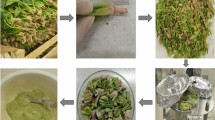A method of extraction with forced circulation of extractant was used for exhaustive extraction of inulin from dandelion roots (Taraxacum officinaleWigg.). Inulin samples were obtained by three methods that were evaluated by inulin yield and purity. The results were used to develop an industrial technology for inulin production from dandelion roots that consisted of extraction of roots with water at 80°C, circulation of the extractant at a rate of 90 L/h, concentration of the extract to 70% dry residue, precipitation of inulin by adding 95% EtOH in a concentrate(EtOH volume ratio of 1:4, and sedimentation for 8 h. Inulin was produced in 30.0% yield of the raw material mass with a purity of at least 80%. The following characteristics were determined: mass loss on drying ≤5.0%; ash content ≤2%; heavy metals ≤0.001%; inulin content ≥80.0%. The resulting product complied with standards for the contents of toxic elements, pesticides, and radionuclides and was safe for use in the pharmaceutical and food industries.


Similar content being viewed by others

References
E. R. Serbaeva, A. B. Yakupova, Yu. R. Magasumova, et al., Biomika, 1, 57 – 79 (2020).
J. Rodriguez, A. M. Neyrinck, M. Van Kerckhoven, et al., BMC Med., 20, 110 (2022).
M. B. Roberfroid, J. Nutr., 137(11), 2493S-2502S (2007).
M. A. Mensink, H. W. Frijlink, K. van der Voort Maarschalk, et al., Carbohydr. Polym., 130, 405 – 419 (2015).
M. A. Mensink, H. W. Frijlink, K. van der Voort Maarschalk, et al., Carbohydr. Polym., 134, 418 – 428 (2015).
I. Yu. Mitrofanova, A. V. Yanitskaya, and Yu. S. Shulenina, Vestn. Nov. Med. Tekhnol., 2, 45 – 46 (2012).
United State Pharmacopeia, 46, NF 41 (2023), www.webofpharma.com.
State Registry of Drugs and Medical Items and Technology Allowed for Use in Medical Practice of the Republic of Uzbekistan [in Russian], No. 27, Min. Health Rep. Uzb. (2023), pp. 616 – 662.
T. L. Kiseleva and Yu. A. Smirnova, Medicinal Plants in Global Medical Practice: State Regulation of Nomenclature and Quality [in Russian], Izd. Professional’noi Assotsiatsii Naturoterapevtov, Moscow (2009).
S. N. Evstaf’ev and N. P. Tiguntseva, Izv. Vyssh. Uchebn. Zaved., Prikl. Khim. Biotekhnol., 1(6), 18 – 29 (2014).
Zh. M. Orozbaeva and T. K. Amankulova, Nauka Nov. Tekhnol. Innovatsii Kyrgyzstana, 4, 7 – 9 (2018).
A. Franck, Br. J. Nutr., 87, 287 – 291 (2002).
M. N. Nazarenko, T. V. Bakhatova, M. A. Kozhukhova, et al., Nauchn. Zh. KubGAU, 94, 10 (2013).
R. V. Mutsaev, I. Yu. Aleksanyan, and N. E. Polikarpova, Ind. Pitan., 3, No. 1, 69 – 76 (2018).
V. D. Artem’ev and Yu. P. Vasil’eva, RU Pat. Appl. 2011114593, Oct. 20, 2012; Byull., No. 29 (2012).
V. V. Lisovoi, T. V. Pershakova, A. G. Kupin, et al., Nauchn. Zh. KubGAU, 118(04), 1 – 14 (2016).
T. Dobre, M. Stroescu, A. Stoica, et al., Chem. Bull. “POLITEHNICA” Univ. (Timisoara), 53(67), 215 – 217 (2008).
E. A. Strupan and O. A. Strupan, RU Pat. 2,351,166, Apr. 10, 2009; Byull., No. 10 (2009).
T. V. Barkhatova, M. N. Nazarenko, et al., RU Pat. 2,548,502, Apr. 20, 2015; Byull., No. 11 (2015).
E. A. Strupan and O. A. Strupan, RU Pat. 2,360,927, Jul. 10, 2009; Byull., No. 19 (2009).
V. V. Maneshin, K. K. Polyanskii, et al., RU Pat. Appl. 2009111945, Oct. 10, 2010; Byull., No. 28 (2010).
N. A. Dyakova, A. A. Myndra, et al., RU Pat. 2,712,554, Jan. 30, 2020; Byull., No. 4 (2019).
T. I. Smirnova, A. K. Oserbaev, et al., RU Pat. 2,485,958, Jun. 27, 2013; Byull., No. 18 (2013).
M.Walz, T. Hirth, and A.Weber, Colloids Surf., A, 536, 47 – 52 (2018).
W. Akram and N. Garud, Future J. Pharm. Sci., 6, 68 (2020).
H. Hang, Y. Li, M. Zhao, et al., Carbohydr. Polym., 95, No. 2, 654 – 656 (2013).
N. A. Ananina, O. A. Andreeva, L. P. Mycots, et al., Pharm. Chem. J., 43, 157 – 159 (2009).
State Pharmacopoeia of the Republic of Uzbekistan [in Russian], 1st Ed., Ministry of Health of the Republic of Uzbekistan, Tashkent (2021).
GOST 26929–94 Raw material and food-stuffs. Preparation of samples. Decomposition of organic matter for analysis of toxic elements, Standartinform, Moscow (2019).
GOST 26927–86 Raw material and food-stuffs. Methods for determination of mercury, Standartinform, Moscow (2010).
GOST 26930–86 Raw material and food-stuffs. Method for determination of arsenic content, Standartinform, Moscow (2010).
Author information
Authors and Affiliations
Corresponding author
Additional information
Translated from Khimiko-Farmatsevticheskii Zhurnal, Vol. 57, No. 8, pp. 67 – 72, August, 2023.
Rights and permissions
Springer Nature or its licensor (e.g. a society or other partner) holds exclusive rights to this article under a publishing agreement with the author(s) or other rightsholder(s); author self-archiving of the accepted manuscript version of this article is solely governed by the terms of such publishing agreement and applicable law.
About this article
Cite this article
Nuridullaeva, K.N., Karieva, E.S. & Khalilov, R.M. Development of Industrial Technology of Inulin Production from Dandelion Roots (Taraxacum officinale Wigg.). Pharm Chem J 57, 1298–1303 (2023). https://doi.org/10.1007/s11094-024-03038-9
Received:
Published:
Issue Date:
DOI: https://doi.org/10.1007/s11094-024-03038-9



